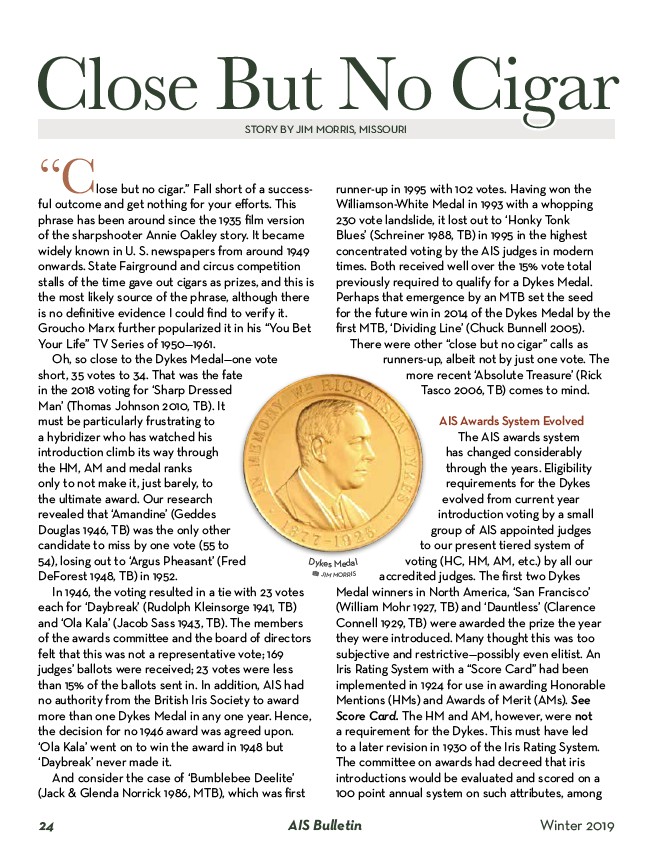
STORY BY JIM MORRIS, MISSOURI Close But No Cigar
“Close but no cigar.” Fall short of a successful
outcome and get nothing for your efforts. This
phrase has been around since the 1935 film version
of the sharpshooter Annie Oakley story. It became
widely known in U. S. newspapers from around 1949
onwards. State Fairground and circus competition
stalls of the time gave out cigars as prizes, and this is
the most likely source of the phrase, although there
is no definitive evidence I could find to verify it.
Groucho Marx further popularized it in his “You Bet
Your Life” TV Series of 1950—1961.
Oh, so close to the Dykes Medal—one vote
short, 35 votes to 34. That was the fate
in the 2018 voting for ‘Sharp Dressed
Man’ (Thomas Johnson 2010, TB). It
must be particularly frustrating to
a hybridizer who has watched his
introduction climb its way through
the HM, AM and medal ranks
only to not make it, just barely, to
the ultimate award. Our research
revealed that ‘Amandine’ (Geddes
Douglas 1946, TB) was the only other
candidate to miss by one vote (55 to
54), losing out to ‘Argus Pheasant’ (Fred
DeForest 1948, TB) in 1952.
In 1946, the voting resulted in a tie with 23 votes
each for ‘Daybreak’ (Rudolph Kleinsorge 1941, TB)
and ‘Ola Kala’ (Jacob Sass 1943, TB). The members
of the awards committee and the board of directors
felt that this was not a representative vote; 169
judges’ ballots were received; 23 votes were less
than 15% of the ballots sent in. In addition, AIS had
no authority from the British Iris Society to award
more than one Dykes Medal in any one year. Hence,
the decision for no 1946 award was agreed upon.
‘Ola Kala’ went on to win the award in 1948 but
‘Daybreak’ never made it.
And consider the case of ‘Bumblebee Deelite’
(Jack & Glenda Norrick 1986, MTB), which was first
runner-up in 1995 with 102 votes. Having won the
Williamson-White Medal in 1993 with a whopping
230 vote landslide, it lost out to ‘Honky Tonk
Blues’ (Schreiner 1988, TB) in 1995 in the highest
concentrated voting by the AIS judges in modern
times. Both received well over the 15% vote total
previously required to qualify for a Dykes Medal.
Perhaps that emergence by an MTB set the seed
for the future win in 2014 of the Dykes Medal by the
first MTB, ‘Dividing Line’ (Chuck Bunnell 2005).
There were other “close but no cigar” calls as
runners-up, albeit not by just one vote. The
more recent ‘Absolute Treasure’ (Rick
Tasco 2006, TB) comes to mind.
AIS Awards System Evolved
The AIS awards system
has changed considerably
through the years. Eligibility
requirements for the Dykes
evolved from current year
introduction voting by a small
group of AIS appointed judges
to our present tiered system of
voting (HC, HM, AM, etc.) by all our
accredited judges. The first two Dykes
Dykes Medal
, jim morris
Medal winners in North America, ‘San Francisco’
(William Mohr 1927, TB) and ‘Dauntless’ (Clarence
Connell 1929, TB) were awarded the prize the year
they were introduced. Many thought this was too
subjective and restrictive—possibly even elitist. An
Iris Rating System with a “Score Card” had been
implemented in 1924 for use in awarding Honorable
Mentions (HMs) and Awards of Merit (AMs). See
Score Card. The HM and AM, however, were not
a requirement for the Dykes. This must have led
to a later revision in 1930 of the Iris Rating System.
The committee on awards had decreed that iris
introductions would be evaluated and scored on a
100 point annual system on such attributes, among
24 AIS Bulletin Winter 2019